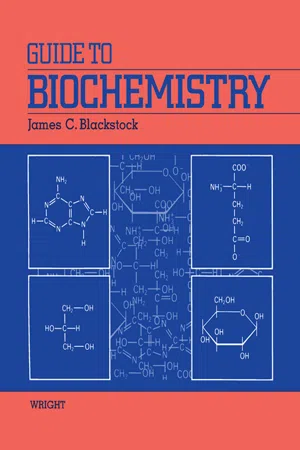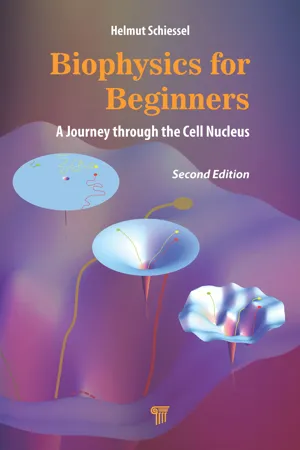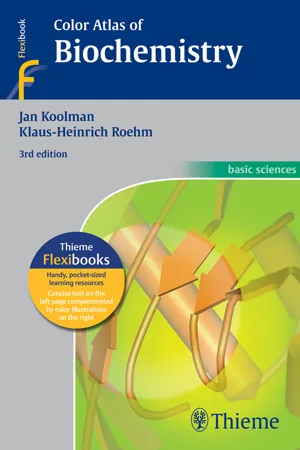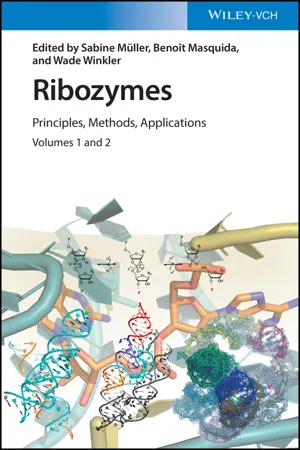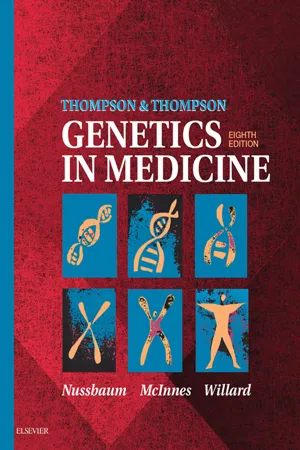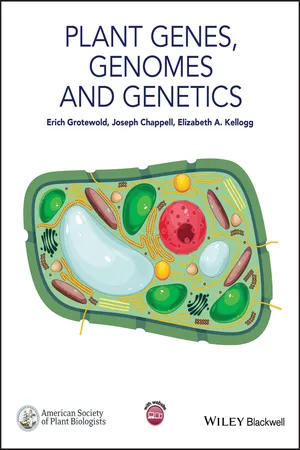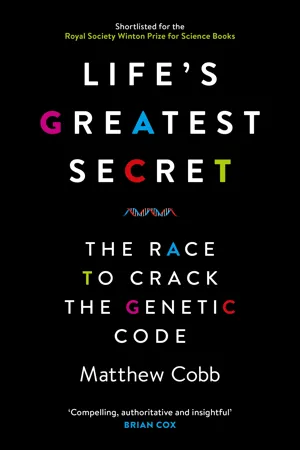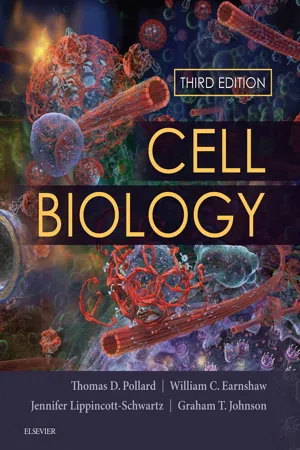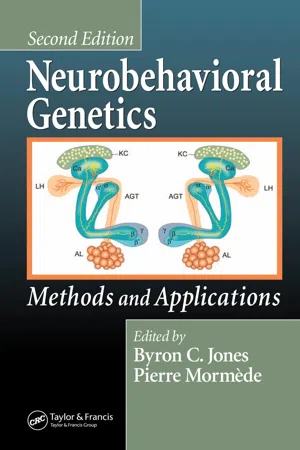Chemistry
Central Dogma
The Central Dogma of molecular biology describes the flow of genetic information within a biological system. It states that genetic information is transcribed from DNA to RNA, and then translated from RNA to proteins. This process is fundamental to understanding how genetic information is expressed and utilized within living organisms.
Written by Perlego with AI-assistance
Related key terms
1 of 5
11 Key excerpts on "Central Dogma"
- eBook - ePub
- James C. Blackstock(Author)
- 2014(Publication Date)
- Butterworth-Heinemann(Publisher)
CHAPTER 17Gene expression
Publisher Summary
This chapter presents the concept of gene expression. The concept of the Central Dogma of molecular biology, formulated in the late 1950s by Francis Crick may be summarized as DNA (deoxyribonucleic acid) →RNA (ribonucleic acid) →protein. Transcription is the process in which RNA is synthesized by enzymes called DNA-directed RNA polymerases. These enzymes use ribonucleoside triphosphates as substrates and DNA as a template. Specific base sequences signal the termination of transcription. Transcription produces RNA molecules. Translation involves two compartments: the cytosol in which individual amino acids are enzymically attached to their specific tRNAs by amino-acid-tRNA ligases and the ribosomes in which the amino acids are correctly positioned according to the base sequence of a mRNA template and polymerized into polypeptide chains. As there are four major bases in mRNA, 43 different codons are possible. The 64 triplets constitute the genetic code. The genetic code applies to prokaryotes and eukaryotic nuclear and chloroplast mRNAs but not to mitochondrial mRNAs. Therefore, the genetic code is quasi-universal.17.1 The Central Dogma
The concept of the Central Dogma of molecular biology (Section 1.6 ), formulated in the late 1950s by Francis Crick may be summarized as DNA (deoxyribonucleic acid) → RNA (ribonucleic acid) → protein.In all living organisms, nuclear DNA serves as the reservoir of genetic information which is expressed in terms of the structure of proteins manufactured by the cell. The base sequence of the DNA determines the amino acid sequence of proteins which are responsible for all aspects of cellular function. Because of cellular organization, synthesis of protein from the DNA blueprint occurs in two stages: transcription, i.e. the synthesis of a messenger RNA molecule of a structure complementary to the structure of DNA so that the genetic information is transferred to mRNA, and upon delivery of the message to the cytosol, its translation into protein. - eBook - ePub
Biophysics for Beginners
A Journey through the Cell Nucleus
- Helmut Schiessel(Author)
- 2021(Publication Date)
- Jenny Stanford Publishing(Publisher)
Chapter 1Molecular Biology of the Cell
1.1 The Central Dogma of Molecular BiologyAn introduction to the fundamentals of the molecular biology of the cell would easily fill this book. Instead, I shall focus on one set of problems in molecular biology that Francis Crick, one of the discoverers of the DNA double helix, has termed the Central Dogma of molecular biology. This Central Dogma states that there are three types of crucial biological macromolecules, DNA, RNA and proteins, that “communicate” in such a way that genetic information flows in the single direction from DNA to RNA to proteins. Figure 1.1 specifies the different steps of that information flow, which we will discuss below.Figure 1.1 The Central Dogma of molecular biology: information flows from DNA to RNA to proteins. The DNA molecules contain the complete genetic information of the cell in the form of genes which are often separated by pieces of “junk” DNA. Each gene is a building plan of a protein. Whenever a cell needs a certain protein, a transcript of its gene is made in the form of an RNA copy. This copy is then used as blueprint to assemble the protein. Also shown are enlarged portions of the three types of macromolecules: DNA and RNA are chemically very similar, except DNA is double stranded whereas RNA is single stranded. Proteins are chemically very different and are made from a sequence of amino acids (aa's). The physical properties of these aa’s cause the protein to fold in a unique three-dimensional shape.The whole genetic information about a cell, its genome, is written down in one or several DNA molecules (DNA stands for DeoxyriboNucleic Acid). When a cell divides, the information must be passed on to its two daughter cells, and therefore the DNA needs to be replicated before the division can take place. To understand how elegant nature’s solution to replication works, we first need to discuss the structure of the DNA chain itself. The genetic text on the DNA chain is made from four letters, the nucleotides: adenine (A), guanine (G), cytosine (C) and thymine (T). These letters are chemically linked into a one-dimensional chain producing a text like AAGCTTAG, but much, much longer. A DNA molecule in a cell carries this information not only once, but effectively twice, since it occurs in a double-stranded form. The two DNA strands are linked via hydrogen bonds through base pairing such that an A is always paired with a T and a G with a C. So our AAGCTTAG strand will be paired with a TTCGAATC strand (more precisely CTAAGCTT, since each strand has a chemically built-in direction and the two strands run anti-parallel). Therefore, the two strands are not identical, but they carry exactly the same genetic information. To duplicate the DNA, the double stranded chain just needs to be unzipped and each strand used as a template to convert it back to a double stranded molecule using the base pairing rules, see Fig. 1.2 - eBook - PDF
- Jan Koolman, Klaus-Heinrich Röhm(Authors)
- 2012(Publication Date)
- Thieme(Publisher)
Molecular Genetics Overview 230 Overview Overview Molecular genetics (“molecular biology”) deals with the biochemistry of the processes in-volved in the storage, transmission, and ex-pression of genetic information. A. “Central Dogma” of molecular biology It was only in the 1950s and 1960s, long after classical genetics had explained the laws gov-erning the inheritance of traits, that the role played by nucleic acids and proteins was rec-ognized. It became clear that genes (p. 232) are DNA segments that contain information for protein or RNA synthesis in coded form. The “Central Dogma” of molecular biology, formu-lated in 1958, describes the information flow in the expression of genetic information (DNA → RNA → protein). B. Expression of genetic information The decisive factor involved in most molecular biological processes is the ability of nucleic ac-ids to enter into specific base-pairings with each other (p. 68). Storage. The genetic information of all cells is stored in the base sequence of their DNA (RNA only occurs as a genetic material in viruses; p. 456). Most genes code for proteins—i.e., they contain the information for the sequence of amino acid residues of a protein (its sequence ). Every amino acid residue is represented in DNA by a code word (a codon ) consisting of a sequence of three base pairs (a triplet ). At the level of DNA, codons are defined as sequences of the sense strand read in the 5′ → 3′ direction (p. 68). A DNA codon for the amino acid phe-nylalanine , for example, is thus TTC (2; p. 246). Replication. During cell division, all of the ge-netic information has to be passed on to the daughter cells. To achieve this, the whole of the DNA is copied during the S phase of the cell cycle (p. 444). In this process, each strand serves as a matrix for the synthesis of a com-plementary second strand (1; p. 238). Transcription. For expression of the genetic in-formation, a DNA sequence has to be converted into a protein sequence. - eBook - ePub
Ribozymes
Principles, Methods, Applications
- Sabine Müller, Benoît Masquida, Wade Winkler, Sabine Müller, Benoît Masquida, Wade Winkler(Authors)
- 2021(Publication Date)
- Wiley-VCH(Publisher)
8 The Ribosome and Protein SynthesisPaul HuterMichael Graf and Daniel N. WilsonUniversity of Hamburg, Institute for Biochemistry and Molecular Biology,, 20146 Hamburg, Germany8.1 Central Dogma of Molecular Biology
Conservation of the genome, its transfer, and faithful implementation of the information stored within are fundamentally important steps in every cell. About 50–60 years ago, the Central Dogma of molecular biology gained prominence for establishing the sequential occurrence of these vital events and their interconnectedness [1 , 2 ]. The classical view describes a consecutive order of events, in which deoxyribonucleic acid (DNA ) can either replicate itself to maintain the genomic integrity (replication) or transfer its information into ribonucleic acid (RNA ) molecules (transcription), which in turn serve as templates for the synthesis of proteins (translation). Together, replication, transcription, and translation form the three founding pillars of the dogma of molecular biology. This model is valid to this day; however, extensive studies over the past decades have broadened our understanding of the molecular mechanisms behind it. Both replication and transcription require the recruitment of macromolecular machines. While replication of the genome requires the action of DNA polymerases, transcription of information from DNA to RNA is mediated by RNA polymerases. RNA molecules are a heterogeneous population that fulfill various roles in a cell and can be divided into two major classes, namely, noncoding RNA (ncRNA ) and messenger RNA (mRNA ). Recent studies have shown that ncRNAs pursue different functions such as catalysis of chemical reactions (e.g. ribosomal RNA [rRNA ]), serving as adaptor molecules (e.g. transfer RNA [tRNA ]) or structural scaffolds (e.g. rRNA) and regulating gene expression (e.g. micro RNA [miRNA ]) [3 , 4 ]. On the other hand, mRNAs contain the information of genes, which can be decoded and translated into proteins. This process is called translation and is mediated by ribosomes. In contrast to the other two molecular machines, the ribosome consists predominantly of rRNA, and the structural and mechanistic themes of the core components are conserved among the three phylogenetic kingdoms of life. However, there are certain differences between, and as well as within, each kingdom concerning size, regulation, and composition, to name but a few [5 , 6 ]. Here we focus exclusively on the prokaryotic ribosomal machinery of Escherichia coli. Unless mentioned otherwise, all ribosomes within this chapter refer to the E. coli - eBook - ePub
Thompson & Thompson Genetics in Medicine E-Book
Thompson & Thompson Genetics in Medicine E-Book
- Robert L. Nussbaum, Roderick R. McInnes, Huntington F Willard(Authors)
- 2015(Publication Date)
- Elsevier(Publisher)
Figure 2-2 .The informational relationships among DNA, RNA, and protein are intertwined: genomic DNA directs the synthesis and sequence of RNA, RNA directs the synthesis and sequence of polypeptides, and specific proteins are involved in the synthesis and metabolism of DNA and RNA. This flow of information is referred to as the Central Dogma of molecular biology.Genetic information is stored in the DNA of the genome by means of a code (the genetic code, discussed later) in which the sequence of adjacent bases ultimately determines the sequence of amino acids in the encoded polypeptide. First, RNA is synthesized from the DNA template through a process known as transcription . The RNA, carrying the coded information in a form called messenger RNA (mRNA), is then transported from the nucleus to the cytoplasm, where the RNA sequence is decoded, or translated, to determine the sequence of amino acids in the protein being synthesized. The process of translation occurs on ribosomes, which are cytoplasmic organelles with binding sites for all of the interacting molecules, including the mRNA, involved in protein synthesis. Ribosomes are themselves made up of many different structural proteins in association with specialized types of RNA known as ribosomal RNA (rRNA) . Translation involves yet a third type of RNA, transfer RNA (tRNA), which provides the molecular link between the code contained in the base sequence of each mRNA and the amino acid sequence of the protein encoded by that mRNA.Because of the interdependent flow of information represented by the Central Dogma, one can begin discussion of the molecular genetics of gene expression at any of its three informational levels: DNA, RNA, or protein. We begin by examining the structure of genes in the genome as a foundation for discussion of the genetic code, transcription, and translation. - eBook - ePub
- Erich Grotewold, Joseph Chappell, Elizabeth A. Kellogg(Authors)
- 2015(Publication Date)
- Wiley-Blackwell(Publisher)
Part IITranscribing Plant Genes
Passage contains an image
Chapter 6 RNA
6.1 RNA links components of the Central Dogma
RNA is an extraordinary, diverse molecule. It comes in many forms and shapes, each with a unique function. Some RNAs are able to transfer information, others can regulate cellular processes, and some catalyze chemical reactions by themselves or in combination with proteins. Perhaps more surprising, a single RNA molecule can perform more than one of these functions. RNA molecules can interact with DNA molecules and with proteins, frequently in a specific manner that is dictated by their structure, the sequence of nucleotides, or both. In this chapter, we will explore the many different kinds of RNAs and their roles in the plant cell. As in DNA molecules, some of the characteristics of RNA molecules are shared by all kingdoms of life, whereas others are specific to plants. Given the importance of the different types of RNA, how, when and what quantity is made is also of fundamental significance. Subsequent chapters in this section describe the enzymes responsible for making RNA from DNA templates, the DNA-dependent RNA polymerases.In Part 1 of this book, we discussed DNA as the blueprint for all the instructions in a cell. Part 2 covers primarily how the DNA code is converted into meaningful directions that permit a cell to carry out all its functions. This flow of information is largely unidirectional, as eloquently pronounced by The Central Dogma of Biology, first enunciated by Francis Crick in 1958, that says “Once information has got into a protein, it can't get out again.” Genetic information thus flows from DNA to RNA to proteins (Figure 6.1 ). Yet, as will be described below, it is now clear that information can also flow from RNA to DNA, and thus the Central Dogma is not as unidirectional as originally thought. RNA plays a central role in this flow of information. However, we will also see that RNA has a number of other fundamental cellular functions, including structural and catalytic roles. A typical eukaryotic cell, such as a plant cell, carries many distinct types of RNA molecules, which can be differentiated by some unique characteristics (Figure 6.2 and Table 6.1 ). Messenger RNA (mRNA), corresponding to just 2–4% of the total RNA in the cell, conveys the bulk of the genetic information from the DNA to the proteins. mRNAs can range in size from a few hundred to several thousand nucleotides. They typically carry a cap at the 5′ end, consisting of modified guanine nucleotide and a 3′ tail formed by up to several hundred adenosine nucleotides (polyA tail). RNA modifications are discussed at the beginning of Part 3 of this book, and mRNAs are a main focus of Chapter 8 - eBook - ePub
Life's Greatest Secret
The Race to Crack the Genetic Code
- Matthew Cobb(Author)
- 2015(Publication Date)
- Profile Books(Publisher)
22 This was the ‘Central Dogma’: once information had gone from DNA into the protein, it could not get out of the protein and go back into the genetic code.*Crick had first come up with the ‘Central Dogma’ phrase and its underlying concept in October 1956, in a set of notes entitled ‘Ideas on protein synthesis’.23 These were not circulated – not even to the RNA Tie Club – but they formed the basis of his discussions with his colleagues and his thinking over the following months. In those original notes – but not in either of the published forms of his talk – Crick included a little diagram to show what he meant.On the original note, Crick playfully wrote ‘The doctrine of the Triad’ (DNA, RNA and protein), but he soon coined the more dramatic term ‘Central Dogma’. As was evident from his presentation of the idea in 1957, it was not, strictly speaking, a dogma (a fundamental belief that cannot be questioned). It was instead a hypothesis, and rather than being based on any a priori position, it was simply based on the available data. Crick later recalled:5. Crick’s first outline of the Central Dogma, 1956, http://profiles.nlm.nih.gov/ps/access/SCBBFT.pdfI called this idea the Central Dogma, for two reasons, I suspect. I had already used the obvious word hypothesis in the sequence hypothesis, and in addition I wanted to suggest that this new assumption was more central and more powerful. I did remark that their speculative nature was emphasized by their names. As it turned out, the use of the word dogma caused almost more trouble than it was worth. Many years later Jacques Monod pointed out to me that I did not appear to understand the correct use of the word dogma, which is a belief that cannot be doubted. I did apprehend this in a vague sort of way but since I thought that all religious beliefs were without any serious foundation, I used the word in the way I myself thought about it, not as most of the rest of the world does, and simply applied it to a grand hypothesis that, however plausible, had little direct experimental support.24 - eBook - ePub
Cell Biology E-Book
Cell Biology E-Book
- Thomas D. Pollard, William C. Earnshaw, Jennifer Lippincott-Schwartz, Graham Johnson(Authors)
- 2016(Publication Date)
- Elsevier(Publisher)
Section IV Central Dogma: From Gene to ProteinOutlineSection IV Overview Chapter 10 Gene Expression Chapter 11 Eukaryotic RNA Processing Chapter 12 Protein Synthesis and FoldingPassage contains an image
Section IV Overview
T he hugely important prediction of a structure for DNA not only led Crick and Watson to propose a general strategy for the replication of DNA (discussed in Chapter 42 ) but also led Francis Crick to propose the Central Dogma of molecular biology: that DNA is transcribed into RNA and that this RNA is then translated into protein. Chapters 10 to 12 present how this Central Dogma plays out at the cellular level, with one crucial addition that could not have been foreseen by Crick. This new element is the complex battery of processing events that RNAs undergo before they function as messengers, transfer vehicles, processing machines, or protein synthesizing machines in the ribosome.Chapter 10 discusses transcription of DNA sequences into RNA, the initial step in recovering the information encoded in the genome. Three eukaryotic cellular RNA polymerases have distinct specialized tasks: polymerase I transcribes ribosomal RNAs; polymerase II transcribes all messenger RNAs (mRNAs) plus a number of small RNA molecules that are involved in RNA processing; and polymerase III transcribes transfer RNAs (tRNAs) and the smallest ribosomal RNAs. These three polymerases evolved from a common ancestor and retain many shared features. However, they have acquired significant differences in the ways they act on their target genes.Eukaryotic genes contain both upstream (5′) and downstream (3′) regulatory regions that are not transcribed into RNA. Each gene has a promoter located just upstream from the site where transcription begins. Enhancers - eBook - PDF
The Human Genome
A User's Guide
- Julia E. Richards, R. Scott Hawley(Authors)
- 2004(Publication Date)
- Academic Press(Publisher)
The stable, long-term infor-mation located in the nuclear DNA gets transcribed to create a temporary messenger RNA that moves out of the nucleus to where ribosomes can use CHAPTER 7: The Central Dogma of Molecular Biology: How Genes Encode Proteins 63 the three-letter genetic code to “read” the message and synthesize a protein. The order of amino acid building blocks in the protein is dictated by the order of bases in the messenger RNA, which is dictated by the order of bases in the region of nuclear DNA that was transcribed to make the RNA, so knowing the DNA or RNA sequence tells us what the protein sequence will be. We have presented the gene and its transcript as being simple co-linear sequences, with the sequence in the DNA exactly corresponding to the sequence in the RNA. In fact, things are rather more complicated than that; Chapter 8 shows some of the complex ways in which the cell manages to make efficient use of some genes to accomplish more than one thing. 64 SECTION 2 THE Central Dogma OF MOLECULAR BIOLOGY FIGURE 7.7 The process of translation. SPLICING THE MODULAR GENE 8 When Ed and Sophia bought their latest computers, they each found themselves faced with a variety of options: different speeds, different amounts of memory, and different peripherals such as speakers and scanners. By the time they were done making their selections, their computers had many things in common, but Ed the database manager had selected an automated tape-drive backup system that Sophia didn’t think she needed, and Sophia the graphic artist had selected high-end graphics card options that Ed knew he didn’t need. Because construction of computers is so modular, it is easy to optimize the features present on each computer without computer companies having to maintain separate lines of instruments with each possible combination of features. The genome makes use of some similar efficiencies by designing some genes to be modular. - eBook - PDF
Neurobehavioral Genetics
Methods and Applications, Second Edition
- Byron C. Jones, Pierre Mormede, Byron C. Jones, Pierre Mormede(Authors)
- 2006(Publication Date)
- CRC Press(Publisher)
73 6 Gene Expression Richard A. Radcliffe CONTENTS Introduction .............................................................................................................. 73 6.1 The Gene ........................................................................................................ 74 6.2 Transcription: Basic Mechanism of mRNA Biogenesis ............................... 76 6.3 Regulation of Transcription ........................................................................... 80 6.4 Transcriptional Regulation through Signal Transduction ............................. 83 6.5 RNA Interference ........................................................................................... 85 6.6 Gene Silencing ............................................................................................... 86 6.7 Sources of Variation in Gene Expression ...................................................... 87 6.8 Measuring Gene Expression .......................................................................... 88 References ................................................................................................................ 92 INTRODUCTION Gene expression, or transcription , is an important element of “The Central Dogma,” the phrase used by Francis Crick 1 to describe what was and still is thought to be the basic and only flow of genetic information in a cell: DNA is transcribed to messenger RNA (mRNA) which is then translated to protein. In this scheme, only nucleic acids actually contain information that is encoded in the specific sequence of nucleotides that make up the DNA or RNA. Cells can construct proteins from the information contained in nucleic acids, but the transfer of information is one way; cells do not have the capacity to reproduce nucleic acid sequence information from proteins alone. - eBook - PDF
11th Hour
Introduction to Molecular Biology
- Deanna Raineri(Author)
- 2009(Publication Date)
- Wiley-Blackwell(Publisher)
Because most genes are present in only one (bacteria) or two (eukaryotes) copies in a cell, the amplification in number of template mole- cules that occurs on passing from DNA to RNA enables cells to synthesize the required amount of protein much more rapidly than if DNA itself was used as the direct template for protein synthesis. It is now known that some genes do not encode proteins but instead are transcribed into func- tional RNAs that play important roles in protein synthesis. In the case of these RNA-coding genes, the flow of genetic information stops at RNA. Topic Test 1: The Central Dogma True/False 1. In the Central Dogma, protein-coding genes are first copied into RNA intermediates, called ribosomal RNAs (rRNA). 2. Beadle and Tatum's one gene-one enzyme hypothesis was renamed one gene one protein and then finally one gene-one polypeptide. Multiple Choice 3. Transcription is the process of a. synthesizing a DNA molecule from an RNA template. b. using a DNA strand as a template to synthesize a complementary RNA molecule. c. using a DNA strand as a template to synthesize an identical RNA molecule. d. assembling ribonucleoside triphosphates (N'TPs) into an RNA molecule without a template. e. synthesizing a protein using information carried in the nucleotide sequence of a messenger RNA. 4. Which of the following statements about Beadle and Tatum's experiments is correct? a. Their wild-type mold cultures were unable to grow on minimal media, but the nutritional mutants were capable of growing on minimal media. b. They hypothesized that each mutant was deficient in a single biosynthetic pathway and that each enzyme in the pathway was specified by the same gene. c. They observed that a mutation in a single gene destroyed the ability of that gene to synthesize a single enzyme. d. Each class of mutant defective in arginine synthesis could be supplemented with a common intermediate, demonstrating that a single gene leads to a single enzyme for each pathway.
Index pages curate the most relevant extracts from our library of academic textbooks. They’ve been created using an in-house natural language model (NLM), each adding context and meaning to key research topics.
